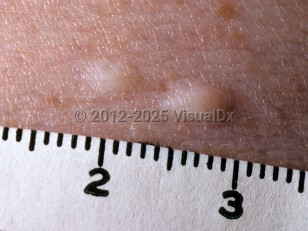Multiple endocrine neoplasia type 1
Alerts and Notices
Important News & Links
Synopsis

Multiple endocrine neoplasia type 1 (MEN1), also known as Wermer syndrome (and previously known as multiple endocrine adenomas and multiple endocrine adenomatosis), is an autosomal dominant endocrine disorder associated with pituitary adenomas, adrenal adenomas, pancreatic endocrine tumors (PETs), and hyperparathyroidism secondary to parathyroid hyperplasia. Foregut carcinoids (bronchial, thymic, and gastric) are also seen in MEN1. Mutation in the MEN1 gene on chromosome 11q13 is the cause of MEN1. Roughly one-fourth of MEN1 patients will have no family history of the disease, and genetic testing for the MEN1 gene is not always positive.
MEN1 is typically not diagnosed until patients are in their 40s. The hallmark finding is hypercalcemia secondary to hyperparathyroidism. However, patients also frequently present with signs and symptoms secondary to a pancreatic endocrine tumor and may have mildly elevated serum calcium. Cutaneous angiofibromas and collagenomas can be helpful diagnostic clues within the setting of hypercalcemia or pancreatic endocrine tumors. Some patients, however, have few skin findings at diagnosis.
MEN1 is also strongly associated with Zollinger-Ellison syndrome (ZES). In patients with both disorders, the diagnosis of ZES can precede the diagnosis of hyperparathyroidism and the initial diagnosis of MEN1 by many years, sometimes decades. Malignant gastrinomas causing ZES are reported in 20% to 70% of patients with MEN1. Thymic carcinoid tumors can be aggressive, and patients can have a number of different neuroendocrine tumors. Melanomas are also associated with MEN1. Menstrual irregularity and infertility can occur secondary to a prolactinoma.
Related topics: MEN2a, MEN2b
MEN1 is typically not diagnosed until patients are in their 40s. The hallmark finding is hypercalcemia secondary to hyperparathyroidism. However, patients also frequently present with signs and symptoms secondary to a pancreatic endocrine tumor and may have mildly elevated serum calcium. Cutaneous angiofibromas and collagenomas can be helpful diagnostic clues within the setting of hypercalcemia or pancreatic endocrine tumors. Some patients, however, have few skin findings at diagnosis.
MEN1 is also strongly associated with Zollinger-Ellison syndrome (ZES). In patients with both disorders, the diagnosis of ZES can precede the diagnosis of hyperparathyroidism and the initial diagnosis of MEN1 by many years, sometimes decades. Malignant gastrinomas causing ZES are reported in 20% to 70% of patients with MEN1. Thymic carcinoid tumors can be aggressive, and patients can have a number of different neuroendocrine tumors. Melanomas are also associated with MEN1. Menstrual irregularity and infertility can occur secondary to a prolactinoma.
Related topics: MEN2a, MEN2b
Codes
ICD10CM:
E31.21 – Multiple endocrine neoplasia [MEN] type I
SNOMEDCT:
30664006 – Multiple endocrine neoplasia, type 1
E31.21 – Multiple endocrine neoplasia [MEN] type I
SNOMEDCT:
30664006 – Multiple endocrine neoplasia, type 1
Look For
Subscription Required
Diagnostic Pearls
Subscription Required
Differential Diagnosis & Pitfalls

To perform a comparison, select diagnoses from the classic differential
Subscription Required
Best Tests
Subscription Required
Management Pearls
Subscription Required
Therapy
Subscription Required
References
Subscription Required
Last Updated:01/19/2022
Multiple endocrine neoplasia type 1

